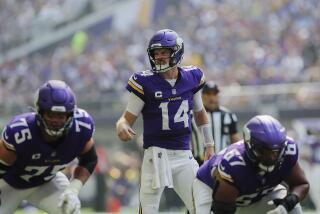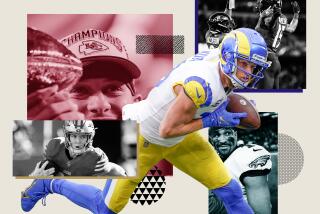Injury Luck
One of the season’s surprise success-story teams, the NFL’s New Orleans Saints, will line up in St. Louis Sunday without the two Saints who did the most to turn things around this fall in the Superdome.
They are Jeff Blake, the quarterback who broke a foot in thefirst quarter of the Oakland game Sunday as New Orleans’ winning streak ended at six, 31-22, and Ricky Williams, the running back who broke an ankle seven days earlier.
“Injuries are by far the worst thing about football,”Oakland owner Al Davis says. “It’s such a beautiful game until people get hurt.”
You can look it up: Injury luck controls the destiny ofevery good pro club.
* * * *
Injury Luck Good and Bad
The Denver Broncos present the most conspicuous recentexample of NFL injury luck--good and bad.
Like most champions before them, and after, the 1997-98Broncos escaped serious injury to win consecutive Super Bowls.
Then in 1999-2000, Denver lost many of its best players,running back Terrell Davis and quarterback Brian Griese among them, and can’t get back tothe top.
Injury luck influences other sports, too, but it’s seldomthe controlling influence elsewhere.
When you hit a home run, you rarely break an ankle joggingaround second base.
You seldom break a foot dunking a basketball.
In most sports, injuries are a nuisance.
In football, they’re a menace.
* * * *
Wounded Saints Hit Cleanly
Because human beings are involved in eight or 10 violentcollisions on every play of every NFL game, sports fans expect and accept injuries as afact of life in football.
Still, some of football’s worst injuries are suffered onfluke plays.
More than one seemingly superbly-conditioned running backhas taken a season-ending hit from himself--while cutting sharply, perhaps, to evade anopponent.
Football is, in fact, so continuously threatening to thehuman body that many players are critically injured on simple, routine plays.
Thus on Nov. 12, New Orleans running back Williams broke hisankle on an end run when tackled cleanly, almost gently, by but one opponent.
A week later, the New Orleans quarterback, Blake, was hurtand lost when, on a sprint toward the sideline, he was tackled cleanly, almost gently,from behind.
Neither of the Saints’ injured stars was piled on or otherwise abused.
Neither was a victim of unsportsmanlike conduct.
Both were victims of the game they love.
* * * *
Favre Simply Ignores Injuries
The unseen weapon that destroys more talented footballplayers than any other one thing is a personal lack of tolerance for injury.
Some of those who in high school demonstrate NFL-classaptitude for the game, offensively or defensively, learn then or in college that theycan’t handle the injuries that are built into football.
So they drop quietly out.
At the other end of the scale are those who, like Green Bayquarterback Brett Favre, quietly illustrate the almost inhuman tolerance for injury thatthe great players have.
You’ve seen Favre smashed around in game after game on playafter play, taking the kind of punishment every week that would end the careers if not thelives of most of the sports fans who fantasize themselves as quarterbacks.
Yet Favre has started 136 consecutive NFL games, theall-time record for quarterbacks.
More than that, just before he saw Indianapolis Sunday, Favre cast away the crutches and cast off the cast that had protected his mangled foot--for six painful days--and beat the Colts, 26-24.
That is tolerance.
* * * *
Good Coaches Resist Discovery
In New Orleans this season, the new leader, Jim Haslett isproving something else: You can never tell about any new head coach.
There is nothing whatever in his record to suggest thatHaslett, who was 7-3 before his quarterback was injured, would join Mike Martz of theRams in the select handful of effective new NFL coaches--the most effective, possibly,since the arrival of Denver Coach Mike Shanahan some years back.
Maybe you weren’t surprised when Haslett, a lifelongdefensive player and coach, converted the sad-sack Saints into an instant defensive powerthis year.
But everyone in the league had to have been surprised whenHaslett’s backup quarterback--a virtual rookie named Aaron Brooks--played the Raidersto a standstill on one of Oakland quarterback Rich Gannon’s biggest days of an MVPseason.
When Brooks moved in to operate Haslett’s deceptively smoothoffense, the Saints were losing by 10 points, 10-0.
In the end, they lost by 9, 31-22.
The kid had led the Saints to three field goals and twotouchdowns, throwing for both touchdowns--one a 53-yard bomb.
That tells you something about . . . the new quarterback?
No, the new coach.
* * * *
Raiders Couldn’t See Haslett
As NFL people said of an obscure lifelong assistant coachnamed Vince Lombardi when, at Green Bay in 1959, he launched the greatest coaching careerin football history, one game doesn’t make a season, and one season doesn’t proveanything.
Haslett could yet fall on his face.
But somehow, I don’t think that will happen.
To watch Haslett at work is to see a coach who shows quiteplainly that his act is together.
Strangely--it is coincidence, indeed--Haslett’s pre-head coaching background is similar to Lombardi’s.
At the height of the Lombardi career in 1965, the NFL wasstill asking: Why didn’t the New York Giants promote him in the 1950s when he was on theircoaching staff?
Today, the NFL is asking: Why didn’t the Saints promoteHaslett in the 1990s when, for three years, they had him on their staff?
Or: Why didn’t Davis promote Haslett when he was a Los Angeles Raider assistant in 1994, the year the Raiders replaced Art Shell with Mike White?
Although one difference between them is that Lombardi was anoffensive assistant whereas Haslett has always locked into defense, the truth is thatHaslett coaches a brighter offense than Lombardi ever had.
That’s strange, too, although nobody could see it for years.
This is a business that defies anyone to hire a winner.
And for awhile, you never know whether you’ve gotone.
You never know about any new coach.
* * * *
Turnovers Still Overrated
More evidence that the average turnover is the mostoverrated aspect of the average football game--the fall-guy play for the coach--waspresented in Nashville on Sunday when the Tennessee Titans turned the ball overseven times, on three interceptions and four fumbles, and still overcame Cleveland easily,24-10.
The result was reminiscent of the one in San Francisco in1981 when the 49ers, with Joe Montana at quarterback, turned the ball over six times andstill beat Dallas for the NFC title, 28-27, en route to their first of five Super Bowlchampionships.
In the Bay Area ever since, that 1981 49er-Cowboy game has been called, simply, “The Catch,” in honor of the winning touchdown pass.
Montana threw three interceptions that day, when he and histeammates also lost three fumbles, to prove that in football games, it isn’t turnoversthat lose--or win--it’s what you do after the turnovers.
As a rule, the winners in close NFL games are those who,after a turnover, continue to attack with the smarter game plan and with the deeper desireto win.
Typically, it is coaches and their followers who talk themost about fumbles and interceptions.
A losing coach is aware of just what he means by aturnover.
What he desperately wants you to believe is, “I dideverything right, but my players screwed up.”
* * * *
Baltimore Best Balanced
Although the national consensus this week is that Tennessee,Oakland, St. Louis and Minnesota are America’s top teams, my view is that the BaltimoreRavens are better balanced than any of them and hence the NFL’s best-balanced team--ifnot the best all-around team--whenever their new quarterback, Trent Dilfer, is distributing passes judiciously.
And that’s the rub.
Continuing an old habit, Dilfer has thrown two or threeseemingly foolish interceptions in the last two weeks.
At the same time, his completions have been more accuratelythrown, far and near, than those of most other 2000 passers, meaning that Dilfer has consistently overcome his mistakes--most recently in leading Baltimore past Dallas, 27-0.
Baltimore Coach Brian Billick, whose won-lost record hasrisen to 8-4 during Dilfer’s three-game winning streak this month, obviously knows theman’s limitations, and has just as obviously been unable yet to make a full correction.
Billick, therefore, seems to be predicting that Dilfer willfrom now on throw more touchdown passes than interceptions and so keep Baltimore winningall winter--as, most likely, a wild-card playoff team.
A continuously successful Dilfer would surprise thecountry’s large anti-Dilfer society but not necessarily the rest of the country.
* * * *
Anatomy of An Interception
Dilfer’s worst interception as Baltimore’s new starter wasdispatched in the Dallas game when he threw deep to a closely-covered wide receiver on afirst-down play in the third quarter.
Earlier, he had hit the same receiver, Qadry Ismail, on asimilar long pass when Ismail was similarly well guarded, but that one, fired on secondand three, worked for a touchdown, apparently giving Dilfer some false confidence.
There didn’t seem much point in going back to the well, backto a well-blanketed Ismail deep, in the third quarter, on first and 10, at the Dallas 25--with two more downs on which to recover and sustain what would have been a 65-yard touchdown drive.
After reviewing that play, Billick obviously still believes that Dilfer’s satisfactory accuracy 90 to 95 percent of the time will atone for his bloopers--and he has the defense to help in the atonement.
For example, on three different occasions in the Dallas game, the Colts tackled Dallas pass receivers exactly one yard short of a first down, and thereafter never budged a half inch.
That’s an extraordinary defense--Dilfer couldn’t ask for more--and in addition, the design of Billick’s offense would give any passer, even an erratic passer, a splendid chance to win every time out.
* * * *
Who Drives the Vikings?
The Minnesota Vikings’ many fans keep wondering what’s mostimportant about that club.
Who keeps the Vikings going so powerfully?
Is it wide receiver Randy Moss, as some insist?
Is it running back Robert Smith, of whom Coach Dennis Greenwas speaking the other day when he announced: “Our whole offense comes off Robert”?
Is it Green himself--the candidate of many for coach of the year?
I think it’s Daunte Culpepper, the 250-pound virtual rookiequarterback.
Culpepper’s passing, which dismantled Carolina Sunday, 31-17, is the key to the Minnesota offense, which owes an assist to offensive coordinator Sherman Lewis.
In the Carolina game, Culpepper and Lewis showed what theymean to the Vikings on the first-half play that put them ahead of the Panthers to stay, 14-7.
Most fans who saw that one thought of the play as a fast53-yard touchdown run by Smith.
Actually, it was a carefully contemplated and constructedscreen pass, Culpepper to Smith, that began as a fake plunge, continued as a fake reverseand then a fake long pass, and ended with a uniquely well-timed throw to Smith.
The designer, Lewis, called it on third and one after Smithhad opened the series with a darting nine-yard run.
Thus the Panthers, who were expecting another run, tackledthin air as Culpepper and then Smith let them have something else.
Of the NFL’s best teams, the Vikings, nonetheless, don’thave enough defense to win the Super Bowl.
Nor has Oakland, even in Gannon’s peak season.
Nor, it may develop, have the Rams.
And it looks more and more every week as if Tennesseedoesn’t have--or, rather, doesn’t seem to want to have--enough offense.
The Titans still figure, but Baltimore’s nicely balancedRavens may steal it yet--if Dilfer doesn’t throw it away.
More to Read
Go beyond the scoreboard
Get the latest on L.A.'s teams in the daily Sports Report newsletter.
You may occasionally receive promotional content from the Los Angeles Times.










